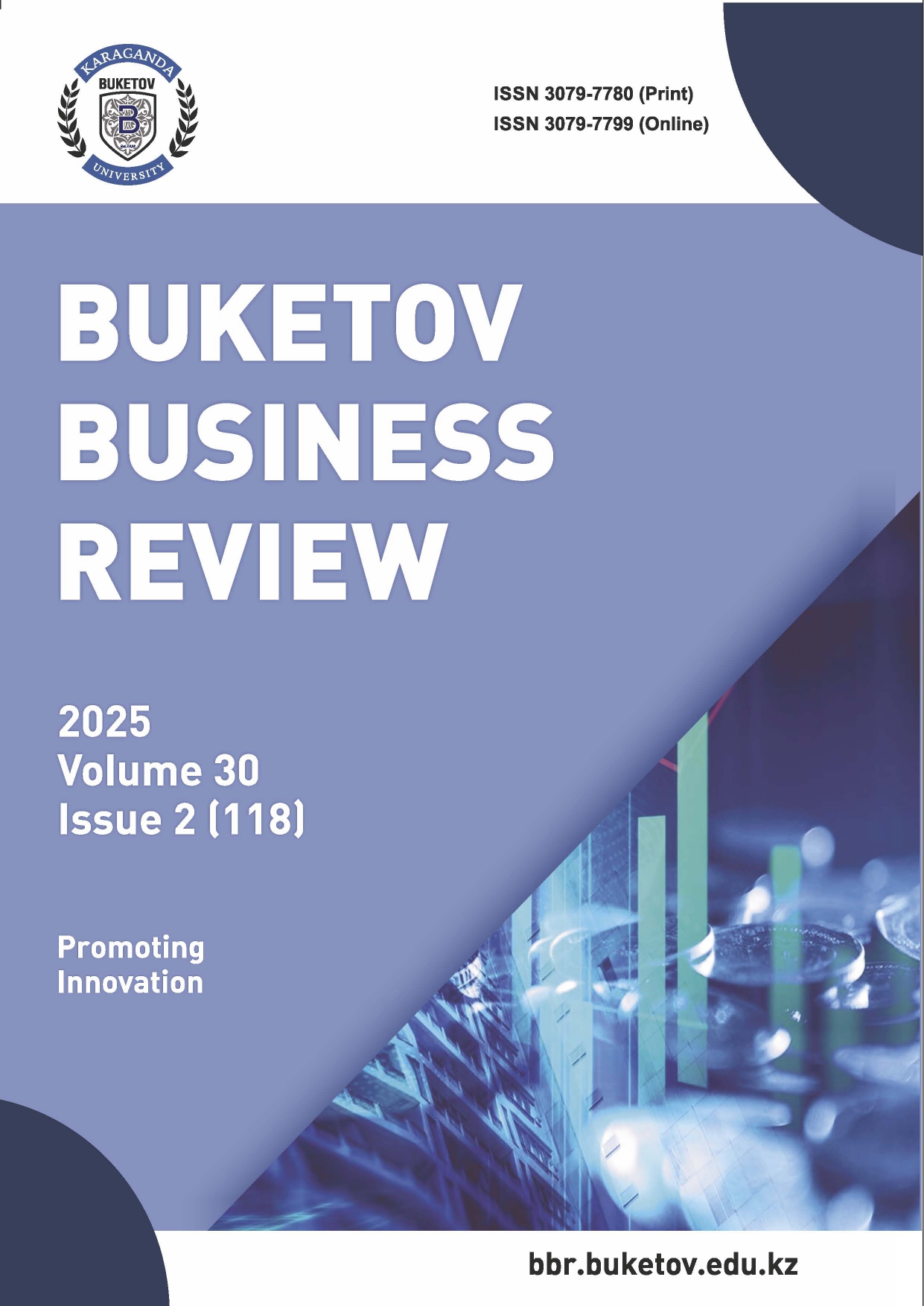Quality of education and its role in eliminating gender barriers in Kazakhstan
DOI:
https://doi.org/10.31489/2025ec2/31-40Keywords:
education, gender equality, quality, government, digitalization, labor market, tertiary education, KazakhstanAbstract
Improving the quality of education and achieving gender equality are considered key conditions for sustainable social and economic development. The study aims to identify the factors influencing gender inequality in Kazakhstan, with an emphasis on the role of the education system in ensuring equal access and reducing differences in the labor market. The study’s methodological framework included four stages and relied on quantitative and qualitative data analysis. The quantitative part is based on national statistics data for 2008–2024 and the results of a questionnaire survey of 104 respondents. The qualitative study included the interpretation of individual responses and an assessment of the perception of educational processes. In the first stage, flexplot visualization displayed the data structure and trends. In the second stage, principal component analysis was conducted to reduce the dimensionality of the data and highlight key factors. The third stage was multiple regression analysis aimed at quantitatively assessing the impact of investments in education, digital infrastructure, and economic activity on the level of gender inequality. In the fourth stage, a substantive analysis of the perception of the quality of education and its connection with ideas about equality was carried out. Thus, investments in education and professional development contribute to reducing gender differences, while digital connectivity did not demonstrate a statistically significant impact. Most importantly, educational opportunities and quality teaching were identified as key factors. Moreover, the results revealed that public expectations of the role of education are based on availability and quality of education. Education is expected to remove sociocultural barriers and regional disparities and comply with the labor market requirements.
References
(2017). United Nations Development Programme. Gender and employment in the South Caucasus and Western CIS. undp.org. Retrieved from https://www.undp.org/sites/g/files/zskgke326/files/migration/eurasia/GenderandEmploymentin-theSouthCaucasusandWesternCIS.pdf
(2022). International Monetary Fund. Tackling gender inequality: Definitions, trends, and policy designs (IMF Working Paper No. 2022/232). imf.org. Retrieved from https://www.imf.org/en/Publications/WP/Issues/2022/12/16/Tackling-Gender-Inequality-Definitions-Trends-and-Policy-Designs-525138
(2025). UNESCO. Gender equality in education. unesco.org. Retrieved from https://www.unesco.org/en/gender-equality/education
Abbas, F., Abbas, N., & Ashiq, U. (2021). Glass Ceiling Effect and Women Career: Determining factors in Higher Education Institutions. SJESR, 4(1), 1–8. https://doi.org/10.36902/sjesr-vol4-iss1-2021(1-8)
Aftab, M.J., Ali, H.H., & Bashir, R. (2023). The Cultural Barriers Faced by Women in Acquiring Higher Education in Tribal Areas of Pakistan: A Case of Dera Ghazi Khan. IUB Journal of Social Sciences, 5(1), 82–94. https://doi.org/10.52461/ijoss.v5i1.1500
Aikman, S., Halai, A., & Rubagiza, J. (2011). Conceptualizing gender equality in research on education quality. Comparative Education, 47(1), 45–60. https://doi.org/10.1080/03050068.2011.541675
Atria, J., Castillo, J., Maldonado, L., & Ramirez, S. (2020). Economic elites’ attitudes toward meritocracy in Chile: A moral economy perspective. American Behavioral Scientist, 64(9), 1219–1241. https://doi.org/10.1177/0002764220941214
Beaunoyer, E., Dupéré, S., & Guitton, M.J. (2020). COVID-19 and digital inequalities: Reciprocal impacts and mitigation strategies. Computers in human behavior, 111, 106424. https://doi.org/10.1016/j.chb.2020.106424
Bolotnyy, V., & Emanuel, N. (2022). Why do women earn less than men? Evidence from bus and train operators. Journal of Labor Economics, 40(2), 283–323. https://doi.org/10.1086/715835
Chen, S.C., Yang, S.J., & Hsiao, C.C. (2016). Exploring student perceptions, learning outcome and gender differences in a flipped mathematics course. British Journal of Educational Technology, 47(6), 1096–1112. https://doi.org/10.1111/bjet.12278
Chigbu, B.I., & Nekhwevha, F. (2023). Exploring the concepts of decent work through the lens of SDG 8: addressing challenges and inadequacies. Frontiers in Sociology, 8, 1266141. https://doi.org/10.3389/fsoc.2023.1266141
China Briefing. (2025). Gender equality in China’s labor market 2025. china-briefing.com. Retrieved from https://www.china-briefing.com/news/gender-equality-in-chinas-labor-market/
de Matos Pedro, E., Leitão, J., & Alves, H. (2020). Bridging intellectual capital, sustainable development and quality of life in higher education institutions. Higher Education Institutions and Sustainable Development, 217. https://doi.org/10.3390/su12020479
Didier, N. (2021). Does the expansion of higher education reduce gender gaps in the labor market? Evidence from a natural experiment. International Journal of Educational Development, 86, 102467. https://doi.org/10.1016/j.ijedudev.2021.102467
Durand, A., Zijlstra, T., van Oort, N., Hoogendoorn-Lanser, S., & Hoogendoorn, S. (2021). Access denied? Digital inequality in transport services. Transport Reviews, 42(1), 32–57. https://doi.org/10.1080/01441647.2021.1923584
International Labour Organization. Breaking barriers: Unconscious gender bias in the workplace. ILO. webapps.ilo.org. Retrieved from https://webapps.ilo.org/infostories/en-GB/Stories/Employment/barriers-women#women-preference
Khan, S., Zaman, S.I., & Rais, M. (2022). Measuring student satisfaction through overall quality at business schools: a structural equation modeling: student satisfaction and quality of education. South Asian Journal of Social Review, 1(2), 34–55. https://doi.org/10.57044/SAJSR.2022.1.2.2210
Kille, T., Wiesner, R., Lee, S.Y., Johnson Morgan, M., Summers, J., & Davoodian, D. (2022). Capital factors influencing rural, regional and remote women’s entrepreneurship development: An Australian perspective. Sustainability, 14(24), 16442. https://doi.org/10.3390/su142416442
Koskinen Sandberg, P., Törnroos, M., & Kohvakka, R. (2017). The institutionalized undervaluation of women’s work: The case of local government sector collective agreements. Work, employment and society, 32(4), 707–725. https://doi.org/10.1177/0950017017711100
Li, K. (2019). MOOC learners’ demographics, self-regulated learning strategy, perceived learning and satisfaction: A structural equation modeling approach. Computers & Education, 132, 16–30. https://doi.org/10.1016/j.compedu.2019.01.003
Little, A.W., & Green, A. (2009). Successful globalization, education and sustainable development. International Journal of Educational Development, 29(2), 166–174. https://doi.org/10.1016/j.ijedudev.2008.09.011
Macevičiūtė, E., & Wilson, T.D. (2018). Digital means for reducing digital inequality: Literature review. Informing science: the international journal of an emerging transdiscipline, 21, 269–287. https://doi.org/10.28945/4117
Mensah, J. (2019). Sustainable development: Meaning, history, principles, pillars, and implications for human action: Literature review. Cogent social sciences, 5(1), 1653531. https://doi.org/10.1080/23311886.2019.1653531
Mogensen, F., & Schnack, K. (2010). The action competence approach and the “new” discourses of education for sustainable development, competence and quality criteria. Environmental education research, 16(1), 59–74. https://doi.org/10.1080/13504620903504032
Newman, A. (2020). Honour, respectability and “noble” work: descent and gender-based obstacles to the education and employment of young Haalpulaar women in northern Senegal. Children’s Geographies, 18(6), 654–666. https://doi.org/10.1080/14733285.2020.1743820
Pedro, E., Mendes, L., & Lourenço, L. (2018). Perceived Service Quality and Students’ satisfaction in Higher Education: the Influence of Teaching Methods. International Journal for Quality Research, 12(1), 165.
Renn, K.A. (2017). The role of women’s colleges and universities in providing access to postsecondary education. The Review of Higher Education, 41(1), 91–112. https://doi.org/10.1353/rhe.2017.0034
Saeed, S., Ahmad, S., Mushtaq, F., & Samiullah, M. (2023). Barriers and Challenges Faced by Rural Females in Accessing Higher Education in Punjab, Pakistan. Harf-o-Sukhan, 7(3), 661–668. Retrieved from https://harf-o-sukhan.com/index.php/Harf-o-sukhan/article/view/947
Sima, V., Gheorghe, I.G., Subić, J., & Nancu, D. (2020). Influences of the industry 4.0 revolution on the human capital development and consumer behavior: A systematic review. Sustainability, 12(10), 4035. https://doi.org/10.3390/su12104035
Timotheou, S., Miliou, O., Dimitriadis, Y., Sobrino, S.V., Giannoutsou, N., Cachia, R., Martínez Monés, A. & Ioannou, A. (2023). Impacts of digital technologies on education and factors influencing schools’ digital capacity and transformation: A literature review. Education and information technologies, 28(6), 6695–6726. https://doi.org/10.1007/s10639-022-11431-8
Umbara, I.A.A.P., Sujana, I.W., & Negara, I.G.A.O. (2020). Model Pembelajaran Problem Based Learning Berbantuan Media Gambar Seri Berpengaruh Terhadap Kompetensi Pengetahuan IPS Siswa. Mimbar Ilmu, 25(2), 174–186. https://doi.org/10.23887/mi.v25i2.25154
Wong, W.H., & Chapman, E. (2023). Student satisfaction and interaction in higher education. Higher education, 85(5), 957–978. https://doi.org/10.1007/s10734-022-00874-0
Zheng, H., & Weeden, K.A. (2023). How gender segregation in higher education contributes to gender segregation in the US labor market. Demography, 60(3), 761–784. https://doi.org/10.1215/00703370-10653728
Downloads
Published
Issue
Section
License
Copyright (c) 2025 BUKETOV BUSINESS REVIEW

This work is licensed under a Creative Commons Attribution-NonCommercial-NoDerivatives 4.0 International License.



